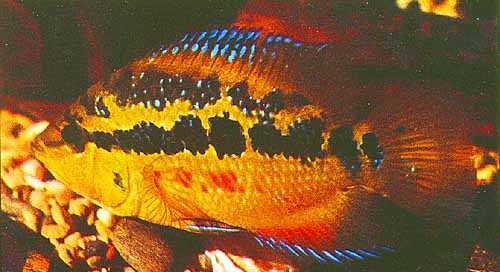Cichlid - Salvini
Scientific Name: Cichlasoma salvini
Fri, 4th April, 2025 - 4:15 pm GMT
Sponsor Ads:

Alternative Name
Scientific Name: Cichlasoma salviniBasic Info
Usually Salvini Cichlids reach mature lengths of six inches (15 centimeters). Females are usually smaller than males. The predominant coloration is yellow. Ventral and dorsal regions are normally bright red, though males' undersides are usually duller than those of most females and may show only a hint of red. Salvini Cichlids are decorated with blue coloring on their upper sides, and blue streaks over the heads.
Health
The temperature of a Salvini Cichlid's enclosure should remain between 75 and 79 degrees Fahrenheit (24 to 26 degrees Celsius). Salvini Cichlids usually do well in pH levels between 6.5 and 8.0. The water hardness should be between 8 and 15 dGH. Plenty of hiding places should be available, like decorations or plants. Salvini Cichlids should only be kept in enclosures alone or with fish of equal size and temperament. They normally do not do well with individuals of the same species. Salvini Cichlids can be fed on live or frozen brine shrimp, bloodworms, or glass worms. Frozen plankton or bits of beef heart, and live fish or tubifex worms, can also be offered. Many Salvini Cichlids do well on tablet or freeze dried foods, though a more natural diet is preferred. Breeding A female Salvini Cichlid is usually distinguished by a dark spot located on her gill covers or a dark patch on her dorsal fin, while males normally have more pointed tips to their anal and dorsal fins and brighter coloration. In the wild, breeding occurs in the warm, dry season between December and May. Salvini Cichlids will pair off and defend a breeding territory, and because of their aggressiveness at breeding season, you should separate breeding pairs from other fish. About 500 eggs are produced and will be deposited on submerged wood, which they clean with their mouths. In conditions of 82 degrees Fahrenheit (28 degrees Celsius), eggs will hatch in two days. During this time, the parents remain near the eggs, aerating them with their fins. The fry are normally consuming their yolk sacs, too heavy to swim, and are placed by the female Salvini Cichlid in a protected area. She moves the young with her mouth. Both parents will care for the young Salvini Cichlids, though usually the male's role is that of defender. In captivity, the male is often removed immediately after fertilization to keep him from breeding the female again or attacking her. The fry should be fed twice daily on small feeder fish.Habitat
Fresh water fish- found in murky waters with little visibilityBehavior
Salvini Cichlids are very beautiful and are often kept as display fish or pets. These lovely fish are interesting to observe in the wild or in captivity. In the wild, Salvini Cichlids are often found in murky waters with little visibility. These are usually bodies of water near vegetation. Leaves and other vegetative materials often litter the waters and lake bottoms where they are found. In captivity, the Salvini Cichlid normally stays in the mid to bottom range of its enclosure. It is, however, quite territorial and may be aggressive to other fish. For this reason, it is recommended that they are kept only with other cichlids of equal size and temperament. They often leave their tanks intact, and do not tend to dig up plants or other items in their gravel.Origin
South AmericaHistory
Wild Salvini Cichlids are found in North and Central America, inhabiting Atlantic drainage rivers and lakes from Mexico to Guatemala and Honduras. The first Salvini Cichlids kept by aquarists were probably brought to Germany from Mexico in 1912, and since they have become quite popular.Common Foods
They eat insects and other small organisms found in the water.Sponsor Ads:
A closed mouth says nothing wrong; a closed mind does nothing right. -- Unknown
Cichlid - Salvini
Coded by: BGID® | ALL RIGHTS RESERVED Copyright © 2000-2025
Disclaimer | Privacy | Report Errors / Contact | Credits


 Preparing For China. China is growing their military. China Military Technology - can it keep up with the US?
Preparing For China. China is growing their military. China Military Technology - can it keep up with the US?  versus
versus 

 versus
versus 
 This Thread is about the North Korean Military itself - the kind of army, navy, and air force they have.
This Thread is about the North Korean Military itself - the kind of army, navy, and air force they have. 
 versus
versus 
 versus
versus  versus
versus